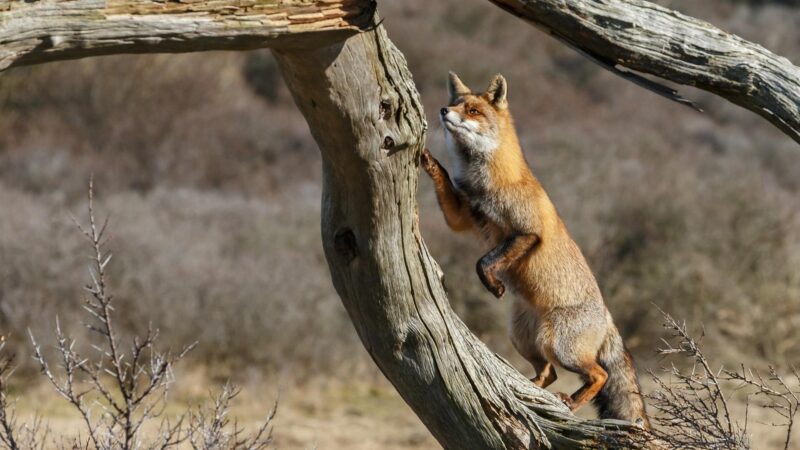Foxes are known for their incredible running speed and physical endurance. They are also able to jump high over fences and roofs of about 3 feet in height.
There are even rare cases and sightings of foxes, not only trotting about and digging around for food in local neighborhoods and communities but also climbing trees.
So, can foxes climb trees? Foxes can climb trees. However, there are only two members of the canine family in the world that can: the gray fox and the raccoon dog. The red fox can also climb, but to an extent. They can jump high enough for smaller trees and shrubbery. Other than these, no other fox species can climb trees.
To know more about how these foxes climb trees, problems that arise when foxes climb trees, other interesting abilities foxes can perform, and how to get rid of foxes if they’re being a bother, read further this article.
Table of Contents
How Do Foxes Climb Trees?

Foxes will leap from the ground towards the trees using their hind legs and then use their forelimbs to hug tree trunks for support.
They can also leap from one tree trunk to another using the same process of leveraging upwards using hind legs and then clutching tree trunks to gain balance.
In other cases, they are found to shimmy themselves when moving upward the tree using both of their legs. They descend to the ground by either running down the tree trunk with their heads facing forward or simply backing up.
Traits That Help Foxes Climb Trees

Tree-climbing foxes have physical traits that allow them to climb trees and even travel from tree to tree by leaping. The following traits are exclusive specifically to gray foxes and can’t be found in other fox species:
1. Sturdy Hind and Fore Legs
Foxes generally have strong bodies with sturdy legs that allow them to run about 50 to 68 kilometers per hour (31 to 42 miles per hour), which is roughly equal to the speed limits of cars on urban freeways.
Tree-climbing foxes put their powerful hind limbs to use when climbing trees by using them to propel themselves both upwards and downwards and even leap from trunk to trunk.
Their forelegs help them anchor or support themselves when they’re grabbing onto parts of the trees. Their legs also help them root themselves in place when trees begin to wobble or they’re hit by winds.
2. Semi-Retractable Claws
Unlike other members of the canid family, such as dogs, coyotes, and other fox species, tree-climbing foxes have hook-shaped claws that are slightly retracted and moveable.
This helps them not only maintain their sharpness and be able to burrow into the ground, but it also allows them to climb trees.
These claws will also help foxes scale trees faster and aid in rooting themselves into place by boring into trunks.
3. Flexible Ankles
Foxes are blessed with naturally flexible ankles that they use to navigate through branches of trees and walk through them properly.
This also helps them escape faster from potential predators during sudden attacks or chase their prey since they can turn their paws at wide angles.
4. Fur Coats
Foxes come with fur coats that can be camouflaged in trees when they’re trying to hide from predators or when they’re stalking their prey. This encourages them to climb on trees more often.
Making a Healthy Environment for Tree-Climbing Foxes

Tree-climbing foxes mean no harm, and they’re highly important for wildlife ecosystems, so it’s best that you try to help them even as little as possible.
This can be done by avoiding spraying pesticides on trees since they can potentially eat the wood. When ingested, it could become fatal for them.
Clean the surrounding area so that foxes can build their dens. Try to feed them with fruit or vegetables but be careful in doing so.
To make sure you won’t get bitten or harmed in any way, try to contact your local ranger or environmental officers.
Problems Associated With Tree-Climbing Foxes
Foxes can cause a ruckus in your local neighborhood by their unpleasant smell and leaving their droppings virtually anywhere as a way of marking their territory.
They also prey on some domestic animals (cats and rabbits) and small livestock (chickens, ducks, and lambs) and may even pose a threat to humans if they’re not healthy foxes.
Raiding your trash cans or compost bins, foxes are natural scavengers who are always on the prowl for food. They can burrow into your gardens, lawns, and wooded areas near houses, not only for food purposes but also to make their dens.
Foxes can also carry contagious diseases, like any other dog, such as rabies.
Can Foxes Be Trained in Climbing Trees?
Foxes can’t be trained in climbing trees because tree climbing is an innate ability and only applicable for gray foxes since they’re the only species that possesses all the ideal physical characteristics that help them climb trees. Training, however, is difficult but not entirely impossible.
How Well Can a Fox Climb?
Most foxes can jump as high as 3 to 6 feet. Gray foxes are considered to be agile creatures that can quickly and effortlessly scale trees that are 18 meters (59 feet) tall, even branchless trees.
Why Do Fox Climb Trees?
The presence of predators activates their fight or flight response to escape. Trees provide good cover that can help them obscure their bodies.
They can also use trees to scavenge the area for prey or look for arboreal food such as eggs from nests and fruits.
Which Fox Species Are Known for Their Tree-Climbing Abilities?

Gray foxes (Urocyon cinereoargenteus) are the only known fox species with genuine tree-climbing abilities. Appearance-wise, they have a reddish hue on their necks and legs and cream white coloration on their throat and belly areas.
They have a distinguishable stripe on their tails which is not found on other fox species. Weighing 8 to 12 pounds, gray foxes are agile and are naturally inclined to climb trees for hiding, food hunting, and even resting.
What Are Other Important Abilities of Foxes?

Foxes have a sharp sense of smell as well as hearing wherein they are able to hear low-frequency sounds such as small animals and insects moving about underground. They can even hear a mouse squeak from 150 feet away.
Aside from that, foxes also have a great sense of direction, thanks to the sensitive whiskers on their faces and legs.
When their whiskers touch anything from their surroundings, the nerve endings send signals to their brains. They then use this information to figure out how to navigate any environment they’re in.
Foxes also have pupils that are shaped like vertical slits, similar to cats, which help them gain night vision abilities and see in the dark well. This works for them the best since they’re naturally nocturnal animals and are active from dawn to dusk.
Frequently Asked Questions
How Small a Gap Can a Fox Get Through?
Foxes can squeeze through holes or gaps that are at least 4 by 4 inches wide.
Can Red Foxes Climb Trees?
Red foxes can climb trees but only relatively shorter trees and shrubbery for the same reasons as gray foxes: food scavenging and escaping from predators. They also possess the same physical qualities that can help them climb small trees.
Can Foxes Climb Wire Fences?
Foxes are proficient jumpers and are able to leap fences with a standard height of 180 millimeters. Some fox species can jump fences that are 6 feet in height.
Can Foxes Climb Walls?
Walls don’t provide the same support with their wooden trunks as concrete walls do. There will be nothing for the foxes to bore their semi-retractable walls. Hence, they are not able to climb walls.
How Do I Get Rid of Foxes?
When foxes become a nuisance in your neighborhood, protect your livestock by keeping them in secure pens, fences, or cages.
Foxes will only be around to prowl at nighttime, so you don’t have to fret about letting your animals roam during the daytime. Having electric fences or netting also works (don’t worry, foxes will only receive minor electric shocks that won’t harm them).
Your neighborhood should also organize weekly, bi-weekly, or monthly clean-ups to pick up potential excess food sources and dead livestock just lying around.
When a fox comes close to your house, simply produce loud noises, and it will be immediately deterred. They’re not normally aggressive but can develop an aversion to humans if they’re unhealthy.
Summary
Foxes, specifically gray foxes, can climb trees of up to 18 feet thanks to their semi-retractable claws, strong limbs, and fur coats.
They do so to avoid predators or locate their prey. They also have incredible senses of smell, hearing, vision, and direction. If uncontrolled, foxes can cause depredations in communities.
It’s best to come prepared with barriers that are effective in keeping foxes out to avoid problems they cause.
List of Sources
Gray Fox Urocyon cinereoargenteus. Cedar Creek Ecosystem Science Reserve.
Fox Nuisance Problems. (2020). Connecticut Department of Energy and Environmental Protection.
Red fox. (2021). Victoria State Government.
Foxes. Maine Department of Inland Fisheries and Wildlife.
Foxes. (2021). Pennsylvania Game Commission.
